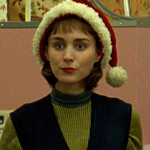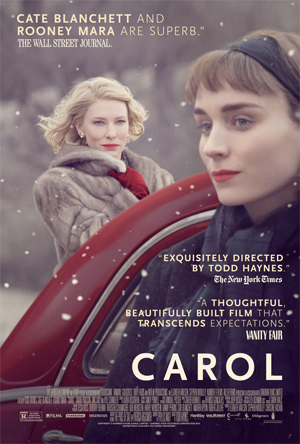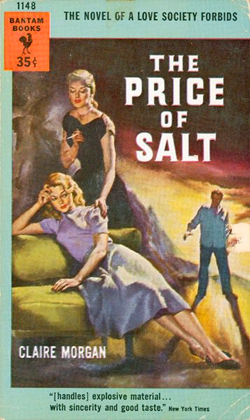 CAROL is a story of love – long, drawn out, dangerous, afraid-to-say-anything love. Young Therese Belivet (Rooney Mara, NIGHTMARE ON ELM STREET remake), working as a shopgirl, seems practically hypnotized when she spots customer Carol Aird (Cate Blanchett, INDIANA JONES AND THE KINGDOM OF THE CRYSTAL SKULL) in her fur coat, Christmas shopping for her daughter. When Carol forgets her gloves on the counter it gives Therese a reason to contact her, and they strike up a relationship outside of the store. Who does Carol think she is, Cinderella? Well, some of the men in the movie treat her like O.J.
CAROL is a story of love – long, drawn out, dangerous, afraid-to-say-anything love. Young Therese Belivet (Rooney Mara, NIGHTMARE ON ELM STREET remake), working as a shopgirl, seems practically hypnotized when she spots customer Carol Aird (Cate Blanchett, INDIANA JONES AND THE KINGDOM OF THE CRYSTAL SKULL) in her fur coat, Christmas shopping for her daughter. When Carol forgets her gloves on the counter it gives Therese a reason to contact her, and they strike up a relationship outside of the store. Who does Carol think she is, Cinderella? Well, some of the men in the movie treat her like O.J.
See, this takes place in the 1952 (five years before CRYSTAL SKULL), when women falling for each other was treated like a shameful crime or a sickness. Carol recently split from her husband Harge (Kyle Chandler [THE WOLF OF WALL STREET], looking more and more like Robert Foster as each minute of the day passes), and he’s still trying to work it out. But when that’s obviously not gonna happen he threatens to use a confessed lesbian incident against her in custody hearings. That’s devastating to her because her daughter is the only thing that matters to her.
It’s a movie where women dance with men and look over at each other from across the room. They have to make up alibis just for being together. Saying Therese is her assistant. If they’re sitting at a table together and a dude comes over and starts talking to them they have to act like he’s not interrupting, and sit and listen to the motherfucker. And he has no idea. He probly figures they’ve been sitting together wishing for a man.
Maybe what makes it so effective is that as Therese discovers these feelings in herself she cannot discuss them, not even with Carol. They go for most of the movie not acknowledging, even to each other, that this is not just two friends eating lunch and traveling. They’re spending all their time together pretending it’s not a big deal to be spending all their time together. In Therese’s mind there must be a fear that if she makes a move it’ll turn out she’s misinterpreting the whole thing and she’ll be humiliated. Or be in trouble.
 This is based on a book by Patricia Highsmith, known as the source material of suspense movies from STRANGERS ON A TRAIN to THE TALENTED MR. RIPLEY (also featuring Blanchett). This is a completely different type of suspense. But they end up on a road trip together where they might as well be fugitives on the lam. And there is a weapon spotted, so it could go south in a bad way. You don’t know.
This is based on a book by Patricia Highsmith, known as the source material of suspense movies from STRANGERS ON A TRAIN to THE TALENTED MR. RIPLEY (also featuring Blanchett). This is a completely different type of suspense. But they end up on a road trip together where they might as well be fugitives on the lam. And there is a weapon spotted, so it could go south in a bad way. You don’t know.
Still, the emphasis is on tiny, sensual things. Staring at neatly kept fingernails. A hand on a shoulder. By the time Carol is standing behind Therese touching her hair it seems undeniable, but it’s still unspoken. The stakes were so much higher then.
Director Todd Haynes (FAR FROM HEAVEN) loves period melodramas, and especially investing them with more modern ideas about sexuality (and sometimes race, but the only black people in this one are a couple who walk by mid-conversation and the camera lingers on them extra long as if to say “Yes, there is other stuff going on besides these white people.”) He’s also very fond of Mara’s big, strange eyes. He must’ve sat around for hours with his camera gazing at her eyes gazing at his camera gazing at her eyes. Or whatever. It works.
Actually I think it’s her eyebrows that draw you in. That’s her secret usually. But in THE GIRL WITH THE DRAGON TATTOO U.S. she didn’t have eyebrows and she was great! That’s why she got the Oscar nomination.
She also got an Oscar nomination for this one, for supporting actress. I get why they would do that, but she’s the lead in my opinion. It’s entirely in her point of view, a young woman who hasn’t quite found herself, stepping nervously into a world of more grown up people. It’s about her working and seeing Carol come into the store, it’s not about Carol going to the store and seeing her. But I guess THERESE (PRONOUNCED TUH-RESS) isn’t as catchy of a title.
(The book was first published as The Price of Salt, but Highsmith later changed it to Carol.)
 The book was groundbreaking in 1952 for telling a story of lesbians where they didn’t (SPOILER I guess) die at the end or otherwise be punished for breaking society’s taboos. Now that I’ve spoiled it I can say that I was real nervous that it was gonna end in tragedy. It kinda seemed like it was headed that way. But I wonder if the ending is intended as more happy than I took it? I mean I’m happy for Carol to be herself, but I don’t feel like this was ever a healthy relationship for Therese. That lady was not looking out for her emotional needs. You get why Therese is into her, but it does not seem to be fulfilling or headed in a better direction. She should go back to that young people party and look more into this Carrie Brownstein situation.
The book was groundbreaking in 1952 for telling a story of lesbians where they didn’t (SPOILER I guess) die at the end or otherwise be punished for breaking society’s taboos. Now that I’ve spoiled it I can say that I was real nervous that it was gonna end in tragedy. It kinda seemed like it was headed that way. But I wonder if the ending is intended as more happy than I took it? I mean I’m happy for Carol to be herself, but I don’t feel like this was ever a healthy relationship for Therese. That lady was not looking out for her emotional needs. You get why Therese is into her, but it does not seem to be fulfilling or headed in a better direction. She should go back to that young people party and look more into this Carrie Brownstein situation.
The Price of Salt: Soon to Be a Major Motion Picture was a personal story to Highsmith, who wrote it quickly with a fever, inspired by seeing a stunning woman in a fur coat while working at Macy’s. It’s terrible to think that Highsmith, whose first novel Strangers On a Train had just been turned into a hit Alfred Hitchcock movie, still had to publish the book under a pseudonym because of its content. She didn’t publicly admit to authorship until many years later.
It’s ridiculous, because nobody should be judged for their sexuality. They should be judged for their character, which in Highsmith’s case was reportedly poor. Supposedly she was a horrible grump who hated everyone (especially Jews) and carried in her purse a head of lettuce covered in snails, her only true friends. Not a joke. She lived with hundreds of them, and smuggled them through airports sometimes by snuggling them under her breasts.
But for such a snail sympathizer it seems she wrote good human characters. It’s interesting to see Haynes adapt them, taking advantage of the freedom to actually do a movie about lesbians while staying true to the restraint and subtlety of a book about the subject from 1952. He mostly just modernizes the acting styles. Well, and one other scene. But he doesn’t turn it into BOUND or something, it’s pretty classical filmatism. Haynes’s film SUPERSTAR: THE KAREN CARPENTER STORY was a biopic made with Barbies. This is a more polished film that looks like it stars porcelain dolls. (Although I wonder if he ever considered doing it with snails?)
To alot of the more-academic-than-me critics and young film students and stuff this seems to be some sort of cinematic second coming, like the MAD MAX: FURY ROAD of movies. I don’t get that at all, but it’s a very good movie. I’m sure one thing they respond to is the polish of it all. It looks great, and it’s kind of cool that while Tarantino was shooting on 70mm and Abrams on Imax Haynes was shooting on Super 16 mm. Sometimes small is good too, if you still have a pretty big screen.
One last thing I want to note is that Harge, who you kind of hate for not getting it, is not entirely a villain. He seems like he is heart broken and really would like to fix the marriage if it was possible. He’s only being an asshole because he’s going along with the times. So let’s always try to step back and make sure our times aren’t making us assholes.



























February 9th, 2016 at 1:13 pm
I liked this movie, found it beautifully shot and extremely well-acted, but the way some critics lost their minds over it doesn’t make much sense to me either. I’m not even sure if it’s one of Haynes’ best films, much less of 2015.